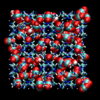A research team consisting of NIMS, the University of Tokyo and the Tokyo University of Science has developed the world’s first technique capable of precisely doping an organic semiconductor in an aqueous solution without requiring a vacuum or a nitrogen atmosphere using special equipment.
This technique—which uses water, previously unexploited for this purpose—could bring about a breakthrough or even a paradigm shift. The study is published in the journal Nature.
Chemical doping is a crucial process in semiconductor device production. Doping organic semiconductors involves the use of redox agents. Because effective redox agents are prone to react with water and/or oxygen, they need to be handled in a vacuum or a nitrogen atmosphere created using special equipment. In addition, these doping methods do not allow precise, consistent adjustment of doping levels.
These issues have long posed major hurdles to technological advances in the organic semiconductor industry.
The research team recently developed a chemical doping technique that uses redox reactions between benzoquinone and hydroquinone in an aqueous solution under ambient conditions. The rate of these redox reactions can be controlled by the acidity of the solution (i.e., pH)—a mechanism also found in electron transport chains in photosynthesis.
The team achieved the chemical doping of organic semiconductor thin films by immersing them in an aqueous solution containing benzoquinone, hydroquinone and hydrophobic ions.
In addition, the team was able to accurately and consistently control the doping levels by changing the pH of the solution, resulting in the production of semiconductors with a wide range of electrical conductivity—approximately five orders of magnitude of difference between the minimum and maximum conductivity.
Flexible, lightweight organic semiconductors can be used as materials suitable for inkjet printing and other low-cost printing processes. The chemical doping technique may be used to promote the industrial production of flexible organic film devices, including sensors, electronic circuits, displays and solar cells.
The proof of concept for a thin-film pH sensor was also demonstrated by employing this novel technique, which suggests possibilities for health care and biosensing applications.
More information:
Masaki Ishii et al, Doping of molecular semiconductors through proton-coupled electron transfer, Nature (2023). DOI: 10.1038/s41586-023-06504-8
Provided by
National Institute for Materials Science
Citation:
Precise chemical doping of organic semiconductors in an aqueous solution (2024, January 12)


